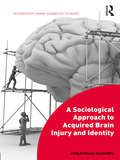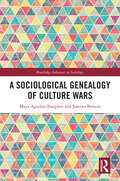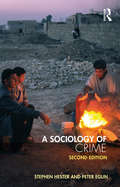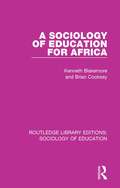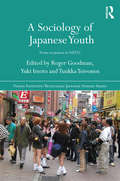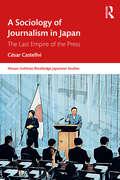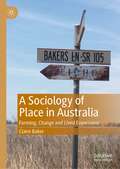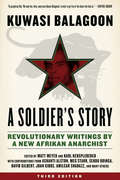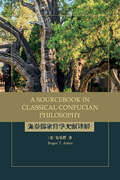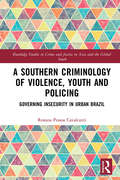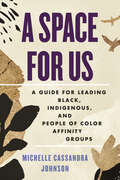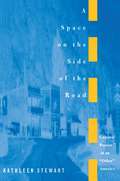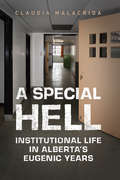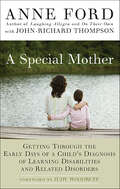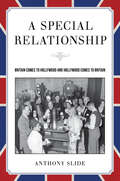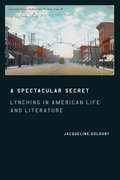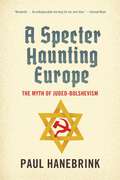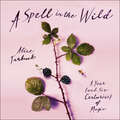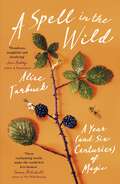- Table View
- List View
A Sociological Approach to Acquired Brain Injury and Identity (Interdisciplinary Disability Studies)
by Jonathan HarveyInspired by the author’s personal experience of sustaining acquired brain injury (ABI), this path-breaking book explores the (re)construction of identity after ABI. It offers a way of understanding ABI through a social scientific lens, promoting an understanding that is generated through close engagement with the lives and experiences of ABI survivors. The author follows the everyday experiences of six male survivors and critically investigates their identity (re)construction after their ABI. As well as demonstrating identity (re)construction after ABI, the experiences of the participants allow the reader to investigate neurological rehabilitation from their perspective. This book suggests that rehabilitation after ABI is often a continual process that extends beyond the formal, medically prescribed period. It also shows that identity after ABI is often (re)constructed in an unpredictable way; a way that emphasises the importance of reciprocal support and the uncertainty of future life. A Sociological Approach to Acquired Brain Injury and Identity is essential reading for academics and students from a range of social scientific disciplines with an interest in biographical or ethnographic research methods. This book offers a social scientific view of rehabilitation and as such is also essential reading for academics, students and professionals with an interest in health and illness, particularly neurological rehabilitation and brain injury rehabilitation.
A Sociological Genealogy of Culture Wars (Routledge Advances in Sociology)
by Maya Aguiluz-Ibargüen Josetxo BeriainThis book analyzes the culture wars as those struggles for the monopoly of the legitimate representation of the world in the normative elucidation of controversial issues linked to values. Public culture in this context would consist of a set of complex classificatory systems of symbols and meanings that constitute a semantic field in permanent dynamic tension. In this work we analyze a whole series of lines of cultural conflict such as the social and semantic genesis of the different forms of “culture war” from the thesis of “modern polytheism” pointed out by Max Weber at the beginning of the 20th century to the national culture wars and the current global culture wars; the social production of truth and the clash with the epistemological tribalisms; the struggles between the new warrior gods, daimons and demons that emerge in modern societies; the struggles of fusion and fission on the symbolic battlefield of “Europe”; the struggles between “pioneers” and “gatekeepers” to define the limits of human nature; the struggles between utopias and dystopias that colonize the present future. This book will be of great help to anybody looking for key interpretations on the nature and structure of modern conflicts in contemporary societies.
A Sociological Perspective on Blood Plasma Donation During the Pandemic: Convalescent Gifts and Liminality (Routledge Advances in Sociology)
by Jae-Mahn Shim Seung-Hyun BaekShim and Baek examine the evolving existential meanings of gift-making by interviewing donors of convalescent blood plasma during the Covid-19 pandemic.The book reveals what plasma donation means for their efforts to reassemble their lives from being liminal moments to livable experiences, through interviews with convalescent donors in South Korea. It shows it is the very multiplex meanings of plasma donations that enabled people to effectively maneuver through the challenging liminality in life during COVID-19, by expanding the existing literature of gifts and donation that highlights the rich, complex meanings of the body parts donated. It presents a vivid dialogue between liminality and gift-making from varied narratives.A vital read for scholars, students of sociology, anthropology, and public health and those interested in how subjects reconstitute their agency amid uncertainty inside and outside the pandemic, so that we appreciate the voices of donors and learn from the lived experiences of those in this book.
A Sociology of Crime: Second edition
by Stephen Hester Peter EglinHester and Eglin’s A Sociology of Crime has an outstanding reputation for its distinctive and systematic contribution to the criminological literature. Through detailed examples and analysis, it shows how crime is a product of processes of criminalisation constituted through the interactional and organizational use of language. In this welcome second edition, the book reviews and evaluates the current state of criminological theory from this "grammatical" perspective. It maintains and develops its critical and subversive stance but greatly widens its theoretical range, including dedicated chapters on gender, race, class and the post-als including postcolonialism. It now also provides questions, exercises and further readings alongside its detailed analysis of a set of international examples, both classical and contemporary.
A Sociology of Education for Africa (Routledge Library Editions: Sociology of Education #8)
by Kenneth Blakemore Brian CookseyThis book, first published in 1980, provides a summary of the major research findings of previous studies of the sociology of education in Sub-Saharan Africa within an original and stimulating general framework whilst also devoting space to their own research findings. The major themes of the book are education and social inequality, the sociology of the school, the teacher and the curriculum, and education and development. The student of the sociology of development will find a stimulating discussion of education in relation to socio-cultural, economic and political change in contemporary Africa.
A Sociology of Japanese Youth: From Returnees to NEETs (Nissan Institute/Routledge Japanese Studies)
by Roger Goodman Yuki Imoto Tuukka ToivonenOver the past thirty years, whilst Japan has produced a diverse set of youth cultures which have had a major impact on popular culture across the globe, it has also developed a succession of youth problems which have led to major concerns within the country itself. Drawing on detailed empirical fieldwork, the authors of this volume set these issues in a clearly articulated ‘social constructionist’ framework, and put forth a sociology of Japanese youth problems which argues that there is a certain predictability about the way in which these problems are discovered, defined and dealt with. The chapters include case studies covering issues such as: Returnee children (kikokushijo) Compensated dating (enjo kōsai) Corporal punishment (taibatsu) Bullying (ijime) Child abuse (jidō gyakutai) The withdrawn youth (hikikomori) and NEETs (not in education, employment or training) By examining these various social problems collectively, A Sociology of Japanese Youth explains why particular youth problems appeared when they did and what lessons they can provide for the study of youth problems in other societies. This book will be of huge interest to students and scholars of Japanese society and culture, the sociology of Japan, Japanese anthropology and the comparative sociology of youth studies.
A Sociology of Journalism in Japan: The Last Empire of the Press (ISSN)
by César CastellviThis book represents an in-depth analysis of journalism in Japan during the golden era of the daily press and the gradual introduction of digital technology starting from the mid-1980s to the late 2010s.By presenting firsthand testimony from journalists and field notes collected from fieldwork in the newsroom of one of the country's largest newspapers, this book provides a unique insight into Japan’s highly active yet relatively under-institutionalized journalistic profession. It also explores the changes experienced by the organizational development of Japanese journalism in response to broader changes in Japanese society, such as the emergence of social networks, the evolution of reading practices, the demographic situation, and the new aspirations of the Japanese youth.Based on an extensive ethnographic fieldwork carried out by the author over several years, this book will be of huge interest to students and scholars of Japanese society, journalism, and media studies.
A Sociology of Place in Australia: Farming, Change and Lived Experience
by Claire BakerThis book weaves a social, economic and cultural history of Australia with rare first-hand accounts of the lived experience of change related to farming and agriculture. It provides a rich sociology of how living on the land has changed throughout Australia’s history. The book investigates the complex effects of the state on everyday life, using an historical agricultural case study of place to explore long-running sociohistorical processes of change examined through both a macro and micro sociological lens. This provides a multi-faceted perspective from which to examine economic, social and cultural transformations in each of these contexts and change is examined through multiple sites of expression: public policy and the role of the state; colonial processes of dispossession; social and cultural systems of value; economic change and its consequences; farming practices and lived experience; neoliberalism and globalisation and their social impacts; community decline and trends toward corporate and foreign land ownership. Each of these transformations impact upon lived experience and everyday life and this book provides grounded insight into exactly this relationship and process.
A Sojourn in Paradise: Jack Robinson in 1950s New Orleans
by Howard Philips SmithJack Robinson made his name as a much-sought-after fashion and celebrity photographer during the 1960s and early 1970s, and his work is well documented in hundreds of pages of Vogue, the New York Times, and Life, as well as other publications. However, his personal life remains virtually unknown. In this study of Robinson and his photography, Howard Philips Smith takes an in-depth look at Robinson’s early life in New Orleans, where he discovered his passion for painting, photography, and the Dixie Bohemian life of the French Quarter. A Sojourn in Paradise: Jack Robinson in 1950s New Orleans features more than one hundred photographs taken by the artist, accompanied by detailed commentary about Robinson’s life in New Orleans and excerpts from interviews with the people who knew him when he lived there. Robinson’s photographs of New Orleans reveal the genesis of two unique and fascinating facets of the city’s history and culture: the creation of the first gay Carnival krewes who would make their own unique contribution to the rich cultural history of the city and the formation of the Orleans Gallery, one of the earliest centers of the contemporary art movement blossoming in 1950s America. This detailed study of Jack Robinson’s early life and photography illustrates the contributions of a gifted, gay artist whose quiet spirit and constant interior struggle found refuge in New Orleans, the city where he was able to find himself, for a time, free from society’s grip and open to exploring life on his own terms.
A Soldier's Story: Revolutionary Writings by a New Afrikan Anarchist (Kersplebedeb)
by Kuwasi BalagoonKuwasi Balagoon was a participant in the Black Liberation struggle from the 1960s until his death in prison in 1986. A member of the Black Panther Party and defendant in the infamous Panther 21 case, Balagoon went underground with the Black Liberation Army (BLA). Balagoon was unusual for his time in that he combined anarchism with Black nationalism, broke the rules of sexual and political conformity, took up arms against the white supremacist State—all the while never shying away from critiquing the movements's weaknesses. The first part of this book consists of contributions by those who knew or were touched by Balagoon; the second consists of court statements and essays by Balagoon himself, including several documents which have never been published before. The third section consists of excerpts from letters Balagoon wrote while in prison. A final section includes a historical essay by Akinyele Umoja and an extensive intergenerational roundtable discussion of the significance of Balagoon's life and thoughts today.
A Source-Book of Modern Hinduism
by Glyn RichardsThrough a balanced selection of texts with commentaries, this work combines an approach to the renaissance of Hinduism and the reformation of Indian society.
A Sourcebook in Classical Confucian Philosophy (SUNY series in Chinese Philosophy and Culture)
by Roger T. AmesApplies a method of comparative cultural hermeneutics to let the tradition speak on its own terms.Roger T. Ames's A Sourcebook in Classical Confucian Philosophy is a companion volume to his Conceptual Lexicon for Classical Confucian Philosophy. It includes texts in the original classical Chinese along with their translations, allowing experts and novices alike to make whatever comparisons they choose. In applying a method of comparative cultural hermeneutics, Ames has tried to let the tradition speak on its own terms. The goal is to encourage readers to move between the translated text and commentary, the philosophical introduction that attempts to sensitize them to the interpretative context, and the companion Lexicon of key philosophical terms, with the expectation that in the fullness of time they will be able to appropriate the original Chinese terminologies themselves. Armed with their own increasingly robust insight into these philosophical terms, readers will be able to carry this nuanced understanding over into their critical reading of other available translations. Ultimately, for students who would understand Chinese philosophy, tian天must be understood as tian天, and dao道must be dao道.
A Southern Criminology of Violence, Youth and Policing: Governing Insecurity in Urban Brazil (Routledge Studies in Crime and Justice in Asia and the Global South)
by Roxana Pessoa CavalcantiA Southern Criminology of Violence, Youth and Policing examines public experiences of insecurity and the social impacts of security programmes that aim to address violence in Brazil. This book contributes to the emerging field of southern criminology by engaging with the perils faced by people living in ‘favelas’ in Brazil and critically investigating the discourse of state actors. It combines original ethnographic data with critical analysis to expand understandings of violence and control in urban and postcolonial contexts. This study challenges dominant practices and notions of security and control. Its objective is to decolonise knowledge and shed light on issues relating to policing, coercion, and the great socioeconomic, historical and spatial inequalities that shape the lives of millions of people in the Global South. The findings of this book expose the exacerbation of social problems by the expansion of the penal and crime industry, unsettling the applicability and universalism of mainstream managerial criminology. The evidence reveals that new modes of securitisation have not addressed long-standing issues of sexism, racism, classism and brutalisation in the police. Moreover, through the increasing use of methods of control and incarceration, security programmes have failed to prevent diverse forms of violence and challenge the expansion of organised crime. Instead they have exacerbated the inequalities that affect the most marginalised populations. Written in a clear and direct style, this book will appeal to students and scholars in criminology, sociology, cultural studies, social theory and those interested in learning about the social injustices that exists in the Global South.
A Space for Us: A Guide for Leading Black, Indigenous, and People of Color Affinity Groups
by Michelle Cassandra Johnson&“A helpful introduction to facilitating affinity spaces in an inclusive, emergent, and trauma-informed way to foster the communal healing spaces that in turn ignite community action and liberation.&”—Resmaa Menakem, best-selling author of My Grandmother&’s Hands and Monsters in LoveThe first comprehensive guide for leading BIPOC affinity groups for challenging white supremacy, healing racial trauma, and taking collective actionMeeting in racial affinity groups is a common practice in anti-racist, social justice, diversity, and similar forms of educational endeavors. These groups provide a structured space in which participants can explore how racism personally impacts them, process specific experiences of racism, receive validation and support from their peers, heal, and strategize next steps for challenging racism, white supremacy, and internalized racial oppression.In A Space for Us, Michelle Cassandra Johnson brings her over 20 years of experience leading dismantling racism work to provide the first affinity groups guide made for BIPOC communities. This essential guide will: Provide an understanding of the racial hierarchy and how it has impacted Black, Indigenous, and People of Color differently.Define and share common manifestations of internalized racial oppression.Define anti-Blackness and provide skills to interrupt and address it. Share rituals, practices, and sample agendas for affinity groups.Explain when it is useful to meet as one BIPOC group and when it is useful to meet based on one&’s specific racial identity.Provide rituals and tools for healing in BIPOC affinity groups.Provide information about how to come back together as BIPOC and white people to strategize and take collective action. Comprehensive and accessible, A Space for Us offers practical guidance for facilitating effective BIPOC racial affinity groups and will be an important resource for BIPOC communities.
A Space on the Side of the Road: Cultural Poetics in an "Other" America
by Kathleen StewartA Space on the Side of the Road vividly evokes an "other" America that survives precariously among the ruins of the West Virginia coal camps and "hollers." To Kathleen Stewart, this particular "other" exists as an excluded subtext to the American narrative of capitalism, modernization, materialism, and democracy. In towns like Amigo, Red Jacket, Helen, Odd, Viper, Decoy, and Twilight, men and women "just settin'" track a dense social imaginary through stories of traumas, apparitions, encounters, and eccentricities. Stewart explores how this rhythmic, dramatic, and complicated storytelling imbues everyday life in the hills and forms a cultural poetics. Alternating her own ruminations on language, culture, and politics with continuous accounts of "just talk," Stewart propels us into the intensity of this nervous, surreal "space on the side of the road." It is a space that gives us a glimpse into a breach in American society itself, where graveyards of junked cars and piles of other trashed objects endure along with the memories that haunt those who have been left behind by "progress." Like James Agee's portrayal of the poverty-stricken tenant farmers of the Depression South in Let Us Now Praise Famous Men, this book uses both language and photographs to help readers encounter a fragmented and betrayed community, one "occupied" by schoolteachers, doctors, social workers, and other professionals representing an "official" America. Holding at bay any attempts at definitive, social scientific analysis, Stewart has concocted a new sort of ethnographic writing that conveys the immediacy, density, texture, and materiality of the coal camps. A Space on the Side of the Road finally bridges the gap between anthropology and cultural studies and provides us with a brilliant and challenging experiment in thinking and writing about "America."
A Special Hell: Institutional Life in Alberta's Eugenic Years
by Claudia MalacridaUsing rare interviews with former inmates and workers, institutional documentation, and governmental archives, Claudia Malacrida illuminates the dark history of the treatment of "mentally defective" children and adults in twentieth-century Alberta. Focusing on the Michener Centre in Red Deer, one of the last such facilities operating in Canada, A Special Hell is a sobering account of the connection between institutionalization and eugenics. Malacrida explains how isolating the Michener Centre's residents from their communities served as a form of passive eugenics that complemented the active eugenics program of the Alberta Eugenics Board. Instead of receiving an education, inmates worked for little or no pay - sometimes in homes and businesses in Red Deer - under the guise of vocational rehabilitation. The success of this model resulted in huge institutional growth, chronic crowding, and terrible living conditions that included both routine and extraordinary abuse. Combining the powerful testimony of survivors with a detailed analysis of the institutional impulses at work at the Michener Centre, A Special Hell is essential reading for those interested in the disturbing past and troubling future of the institutional treatment of people with disabilities.
A Special Mother: Getting Through the Early Days of a Child's Diagnosis of Learning Disabilities and Related Disorders
by Anne Ford John-Richard ThompsonAll mothers experience worries and fears about their children, but none can compare with the early days when a mother feels something's not quite right. Anne Ford knows the feeling. She's had it herself, having raised a daughter with severe learning disabilities, and has gone on to share experiences with others during her many years as a volunteer with the National Center for Learning Disabilities.To bring comfort, support, and hard information to mothers-and fathers, too-in the early period surrounding the diagnosis, here is the book that Anne wishes she'd had years ago when she first received the news about her daughter and didn't know where to turn for the practical and emotional help she desperately needed.Filled with essential advice and the voices of other mothers whose children have LD and related disorders such as Asperger's and ADHD, A Special Mother lets parents know they are not alone and that they can help their child to thrive. This invaluable book addresses such matters as:Understanding Learning Disabilities and Related DisordersWhat Should You Do First?Interpreting Evaluation ResultsResolving DisputesSpecial Fathers: They Are Out ThereThe Social Side of LDAdvocacy vs. ObsessionHow Are You Doing?: Taking Care of Yourself
A Special Relationship: Britain Comes to Hollywood and Hollywood Comes to Britain
by Anthony SlideA Special Relationship provides not only a historical overview of the British in Hollywood, but also a detailed study of the contributions made by American individuals and companies to British cinema from the beginning of the twentieth century onwards. The story begins with Ohio-born Charles Urban who came to London in 1898 and deserves credit for major involvement in the creation of a British film industry. While Ireland was still a part of Britain, the New York-based Kalem Company made films there from 1910 to 1913. British producers realized the importance of American stars, and many actors, beginning with Florence Turner (who was arguably also the first American star), made numerous British films. In the 1920s, such Hollywood stars as Mae Marsh, Betty Blythe, and Dorothy Gish remained active in Britain. In the 1930s, as their careers came to a halt, more than one hundred former American stars made the trip to England, partly as a vacation and partly in the hope of reenergizing their careers.Chapters discuss American cinematographers at work in Britain in the 1920s and 1930s and the introduction of Technicolor to British films. Diversity is represented by African American performers (most notably Paul Robeson), the Chinese American star Anna May Wong, along with female filmmakers from Hollywood. With Britain's declaration of war on Germany, there were Americans who stayed, such as Bebe Daniels and Ben Lyon, contributing to the war effort. America became actively involved in British cinema after World War II, with many Hollywood studios producing films there. As the years progressed, the British film industry became an international film industry. The book concludes with the Harry Potter and James Bond series, indicative of a new international cinema, with financing and behind-the-camera talent coming from the United States, but with British locales and British stars.
A Spectacular Secret: Lynching in American Life and Literature
by Jacqueline GoldsbyThis incisive study takes on one of the grimmest secrets in America's national life—the history of lynching and, more generally, the public punishment of African Americans. Jacqueline Goldsby shows that lynching cannot be explained away as a phenomenon peculiar to the South or as the perverse culmination of racist politics. Rather, lynching—a highly visible form of social violence that has historically been shrouded in secrecy—was in fact a fundamental part of the national consciousness whose cultural logic played a pivotal role in the making of American modernity. To pursue this argument, Goldsby traces lynching's history by taking up select mob murders and studying them together with key literary works. She focuses on three prominent authors—Ida B. Wells-Barnett, Stephen Crane, and James Weldon Johnson—and shows how their own encounters with lynching influenced their analyses of it. She also examines a recently assembled archive of evidence—lynching photographs—to show how photography structured the nation's perception of lynching violence before World War I. Finally, Goldsby considers the way lynching persisted into the twentieth century, discussing the lynching of Emmett Till in 1955 and the ballad-elegies of Gwendolyn Brooks to which his murder gave rise. An empathic and perceptive work, A Spectacular Secret will make an important contribution to the study of American history and literature.
A Spectacular Secret: Lynching in American Life and Literature
by Jacqueline GoldsbyThis incisive study takes on one of the grimmest secrets in America's national life—the history of lynching and, more generally, the public punishment of African Americans. Jacqueline Goldsby shows that lynching cannot be explained away as a phenomenon peculiar to the South or as the perverse culmination of racist politics. Rather, lynching—a highly visible form of social violence that has historically been shrouded in secrecy—was in fact a fundamental part of the national consciousness whose cultural logic played a pivotal role in the making of American modernity. To pursue this argument, Goldsby traces lynching's history by taking up select mob murders and studying them together with key literary works. She focuses on three prominent authors—Ida B. Wells-Barnett, Stephen Crane, and James Weldon Johnson—and shows how their own encounters with lynching influenced their analyses of it. She also examines a recently assembled archive of evidence—lynching photographs—to show how photography structured the nation's perception of lynching violence before World War I. Finally, Goldsby considers the way lynching persisted into the twentieth century, discussing the lynching of Emmett Till in 1955 and the ballad-elegies of Gwendolyn Brooks to which his murder gave rise. An empathic and perceptive work, A Spectacular Secret will make an important contribution to the study of American history and literature.
A Spectacular Secret: Lynching in American Life and Literature
by Jacqueline GoldsbyThis incisive study takes on one of the grimmest secrets in America's national life—the history of lynching and, more generally, the public punishment of African Americans. Jacqueline Goldsby shows that lynching cannot be explained away as a phenomenon peculiar to the South or as the perverse culmination of racist politics. Rather, lynching—a highly visible form of social violence that has historically been shrouded in secrecy—was in fact a fundamental part of the national consciousness whose cultural logic played a pivotal role in the making of American modernity. To pursue this argument, Goldsby traces lynching's history by taking up select mob murders and studying them together with key literary works. She focuses on three prominent authors—Ida B. Wells-Barnett, Stephen Crane, and James Weldon Johnson—and shows how their own encounters with lynching influenced their analyses of it. She also examines a recently assembled archive of evidence—lynching photographs—to show how photography structured the nation's perception of lynching violence before World War I. Finally, Goldsby considers the way lynching persisted into the twentieth century, discussing the lynching of Emmett Till in 1955 and the ballad-elegies of Gwendolyn Brooks to which his murder gave rise. An empathic and perceptive work, A Spectacular Secret will make an important contribution to the study of American history and literature.
A Specter Haunting Europe: The Myth of Judeo-Bolshevism
by Paul HanebrinkIn the 20th century, Europe was haunted by a specter of its own imagining: Judeo-Bolshevism. Fear of a Jewish Bolshevik plot to destroy the nations of Europe took hold during the Russian Revolution and spread across the continent. Paul Hanebrink shows that the myth of ethno-religious threat is still alive today, in Westerners’ fear of Muslims.
A Spell in the Wild: A Year (and six centuries) of Magic
by Alice Tarbuck'Witches occupy a clear place in contemporary imagination. We can see them, shadowy, in the corners of the past: mad, glamorous, difficult, strange. They haunt the footnotes of history - from medieval witches burning at the stake to the lurid glamour of the 1970s witchcraft revival. But they are moving out of history, too. Witches are back. They're feminist, independent, invested in self-care and care for the world. They are here, because they must be needed.'What it means to be a witch has changed radically throughout history; where 'witch' was once a dangerous - and often deadly - accusation, it is now a proud self-definition. Today, as the world becomes ever more complicated and as we face ecological, political and economic crisis - witchcraft is experiencing a resurgence. Witches are back.In A Spell in the Wild, Alice Tarbuck explores what it means to be a witch today. Rooted in the real world, but filled with spells, rituals and recipes, this book is an accessible, seasonal guide to witchcraft in the twenty-first century. Following the course of a witch's calendar year while also exploring the history and politics of witchcraft, A Spell in the Wild is the perfect primer for the contemporary witch.(P) 2020 Hodder & Stoughton Ltd
A Spell in the Wild: A Year (and six centuries) of Magic
by Alice Tarbuck'Witches occupy a clear place in contemporary imagination. We can see them, shadowy, in the corners of the past: mad, glamorous, difficult, strange. They haunt the footnotes of history - from medieval witches burning at the stake to the lurid glamour of the 1970s witchcraft revival. But they are moving out of history, too. Witches are back. They're feminist, independent, invested in self-care and care for the world. They are here, because they must be needed.'What it means to be a witch has changed radically throughout history; where 'witch' was once a dangerous - and often deadly - accusation, it is now a proud self-definition. Today, as the world becomes ever more complicated and as we face ecological, political and economic crisis - witchcraft is experiencing a resurgence. Witches are back.In A Spell in the Wild, Alice Tarbuck explores what it means to be a witch today. Rooted in the real world, but filled with spells, rituals and recipes, this book is an accessible, seasonal guide to witchcraft in the twenty-first century. Following the course of a witch's calendar year while also exploring the history and politics of witchcraft, A Spell in the Wild is the perfect primer for the contemporary witch.
A Spell in the Wild: A Year (and six centuries) of Magic
by Alice Tarbuck'Witches occupy a clear place in contemporary imagination. We can see them, shadowy, in the corners of the past: mad, glamorous, difficult, strange. They haunt the footnotes of history - from medieval witches burning at the stake to the lurid glamour of the 1970s witchcraft revival. But they are moving out of history, too. Witches are back. They're feminist, independent, invested in self-care and care for the world. They are here, because they must be needed.'What it means to be a witch has changed radically throughout history; where 'witch' was once a dangerous - and often deadly - accusation, it is now a proud self-definition. Today, as the world becomes ever more complicated and as we face ecological, political and economic crisis - witchcraft is experiencing a resurgence. Witches are back.In A Spell in the Wild, Alice Tarbuck explores what it means to be a witch today. Rooted in the real world, but filled with spells, rituals and recipes, this book is an accessible, seasonal guide to witchcraft in the twenty-first century. Following the course of a witch's calendar year while also exploring the history and politics of witchcraft, A Spell in the Wild is the perfect primer for the contemporary witch.
